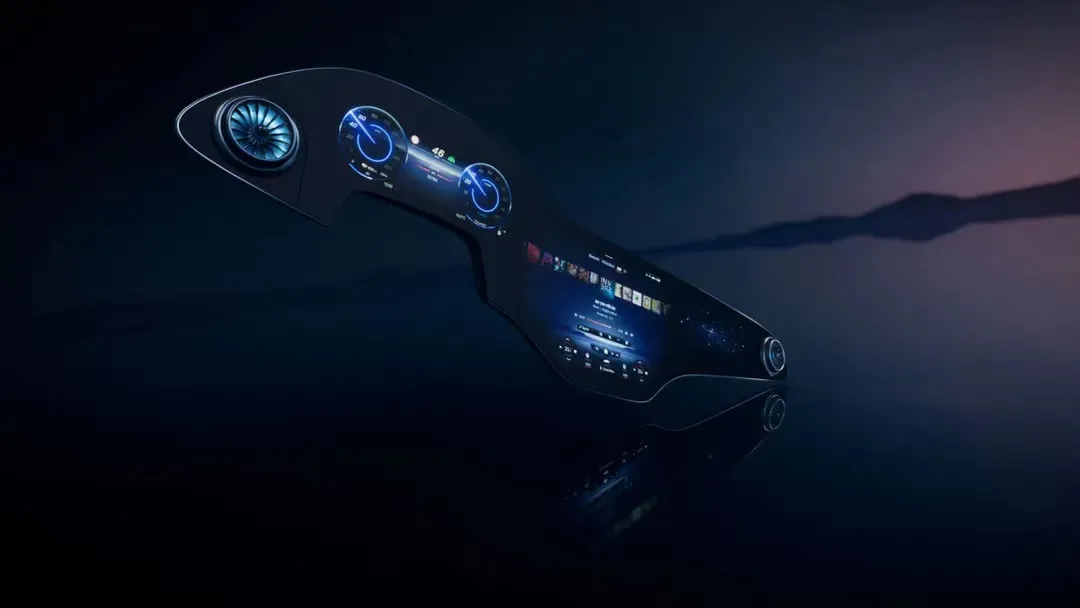*Author: Bernice
At CES earlier this year, the MBUX Hyperscreen mounted on the Mercedes-Benz EQS was globally released, and soon after, Tesla released the 2021 Model S/X, bringing the latest generation of cabin design.
Both of them are focusing on the cabin. Now let’s analyze the highlights of both sides and make a comparative analysis.
Mercedes-Benz MBUX Hyperscreen
The EQS, which has a pure electric cruising range of more than 700 kilometers, is the first representative work of Mercedes’ large pure electric vehicle platform EVA, and the MBUX Hyperscreen is one of its biggest highlights.
According to the official statement, the MBUX Hyperscreen is the largest and most intelligent on-board display screen ever equipped on a mass-produced Mercedes-Benz model. It represents the top intelligent level of its pure electric luxury car, and visually, it can be regarded as a “digital artwork”.
Following the classic dual-screen and the split-screen of the new S-Class, the MBUX Hyperscreen adopts a three-screen integrated design.
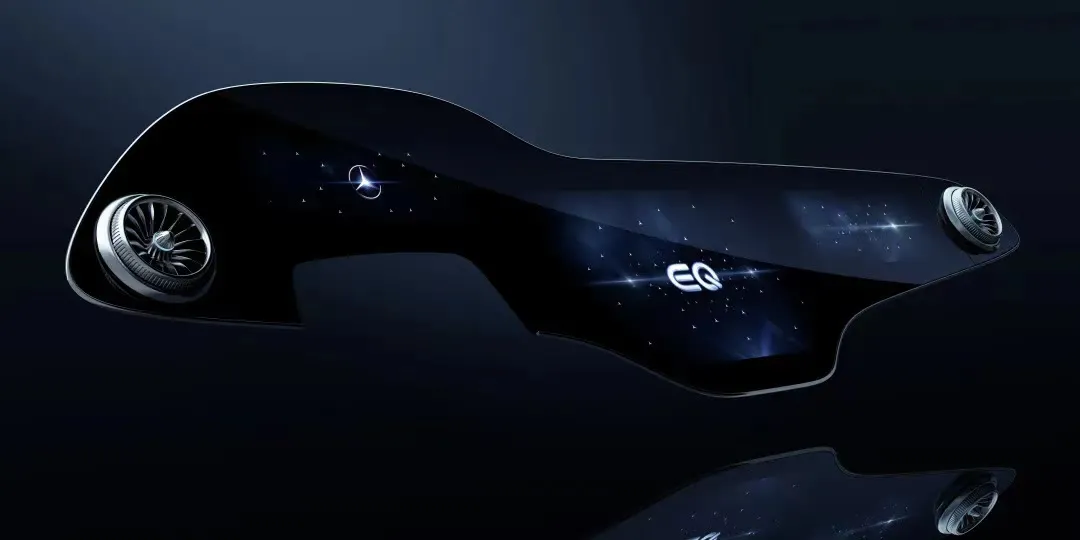
A free-form curved glass seamlessly connects the three displays, extending directly from the left door to the right door with the turbine-shaped air outlet naturally integrated into it. The screen width exceeds 142 centimeters, and it is a seamless design. With the surrounding ambient atmosphere lights, the whole screen seems to be floating above the dashboard, which is wonderful.
The central display screen and the front passenger display screen among the three screens all adopt OLED technology, and the independently illuminated pixels can ensure that no matter how the viewing angle and lighting conditions change, the screen can always present high-contrast picture colors, not only making the image more clear to the user, but also more comfortable.
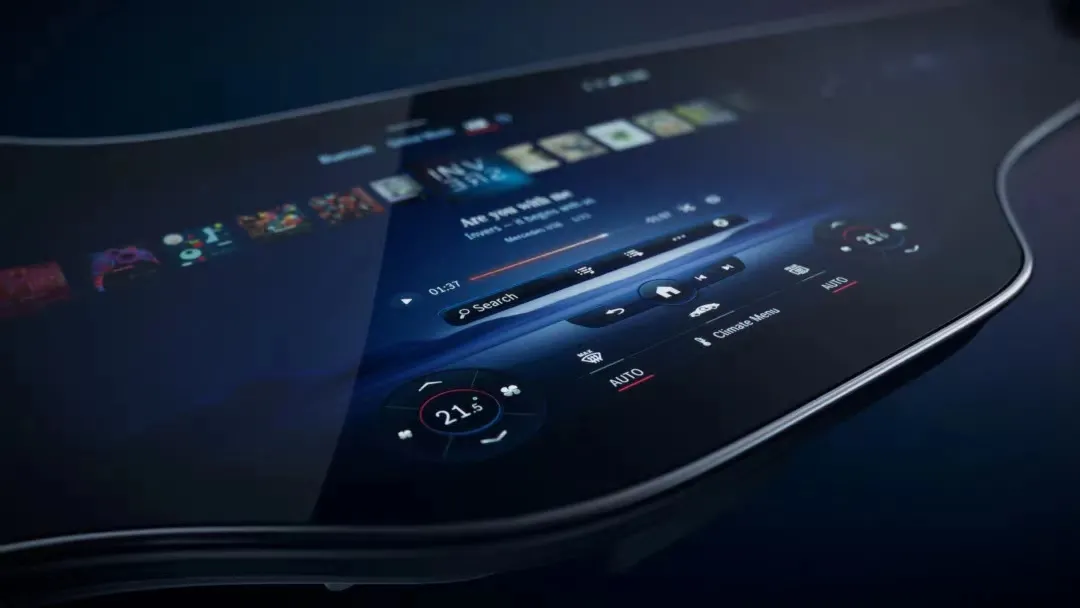
In the instrument panel, Mercedes-Benz engineers have designed more intuitive and vivid digital visual effects for pure electric vehicles, and data such as acceleration and energy recovery can be presented more clearly and beautifully. The G value is quite interesting. It is designed as an EQ ice hockey, which can dynamically display changes in real-time.
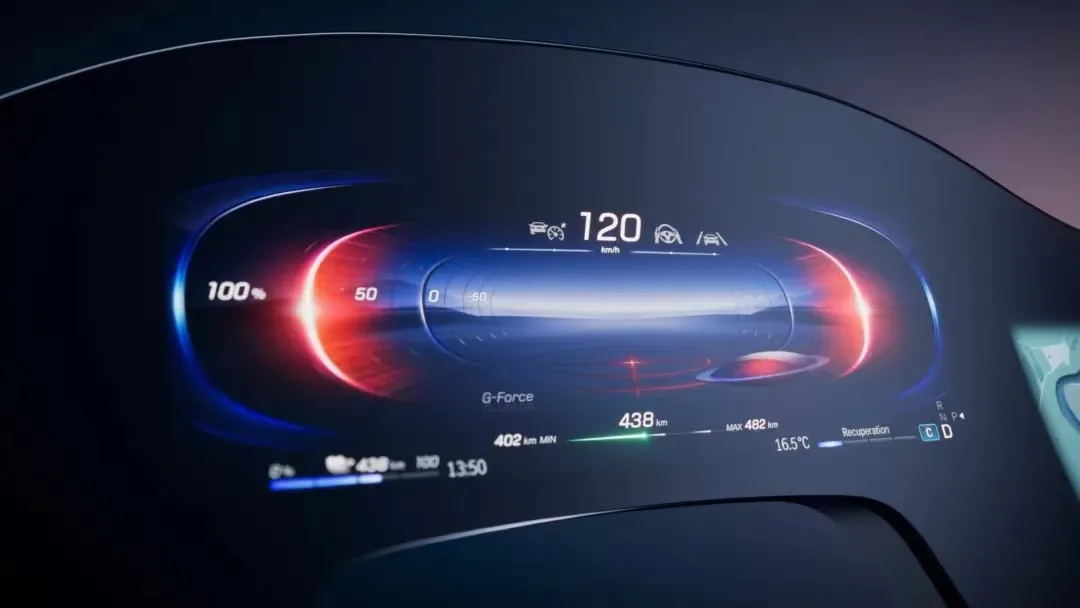
This glass-faced screen adopts aluminum silicate material, and two special coatings that are not only scratch-resistant and effective in reducing reflection, but also easier to clean.Except for the visual impact, Mercedes-Benz still has highlights in touch. There are a total of 12 sensors under the touchscreen, and users will receive corresponding touch feedback when touching the screen.
In terms of practicality, the MBUX Hyperscreen is backed by powerful computing power, including an 8-core CPU, 24GB of memory, and a memory bandwidth of 46.4GB per second. Most importantly, the “zero-logic operation” was introduced this time.
From the official diagram, we can see that the new generation of MBUX adopts an interaction mode with the map as the background and floating windows as auxiliary functions. The functional cards below the map will change in real-time. Mercedes-Benz will proactively provide the required functions to users at the appropriate time through AI and continuously optimize based on environmental changes and user behavior.
According to Mercedes-Benz’s research on the first-generation MBUX users, navigation, multimedia, and telephone communication are the most commonly used functions by most users. So these cards will be resident on the homepage according to user habits. Other functions include proactive massage mode, intelligent induction assistant, and multi-seat entertainment system, all of which can appear or disappear in real-time based on the user’s habits. For example:
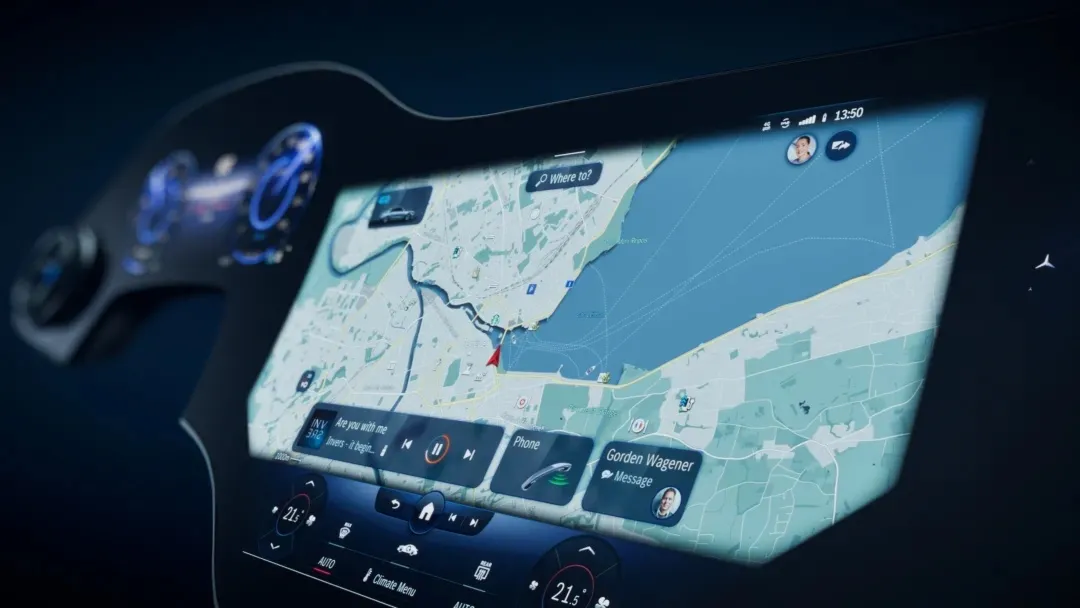
If the user frequently uses massage function based on the hot stone principle, the system will automatically inquire whether to activate this function on the screen on cold days;
If the user has used the chassis lifting function when encountering steep lanes or speed bumps, the system will automatically prompt to lift the chassis when the vehicle approaches the GPS positioning location again;
If the user often starts the steering wheel heating function in addition to seat heating, when the seat heating is turned on, the system will automatically suggest starting the steering wheel heating.
Simply put, the key to MBUX Hyperscreen is aesthetics, innovation, and people-oriented. Compared with the previous generation of MBUX, the MBUX Hyperscreen is still amazing, and I personally think that the zero-logic operation introduced by Mercedes-Benz is really practical and easy to use.
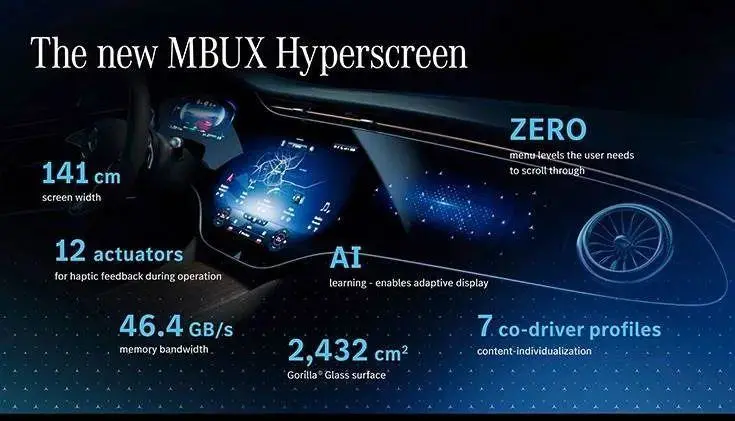
The cabin design of the new generation of Tesla Model S/X
At the end of January this year, Tesla released the Q4 and full-year financial reports for 2020, and the new Model S/X was also unveiled, bringing the latest cabin design.
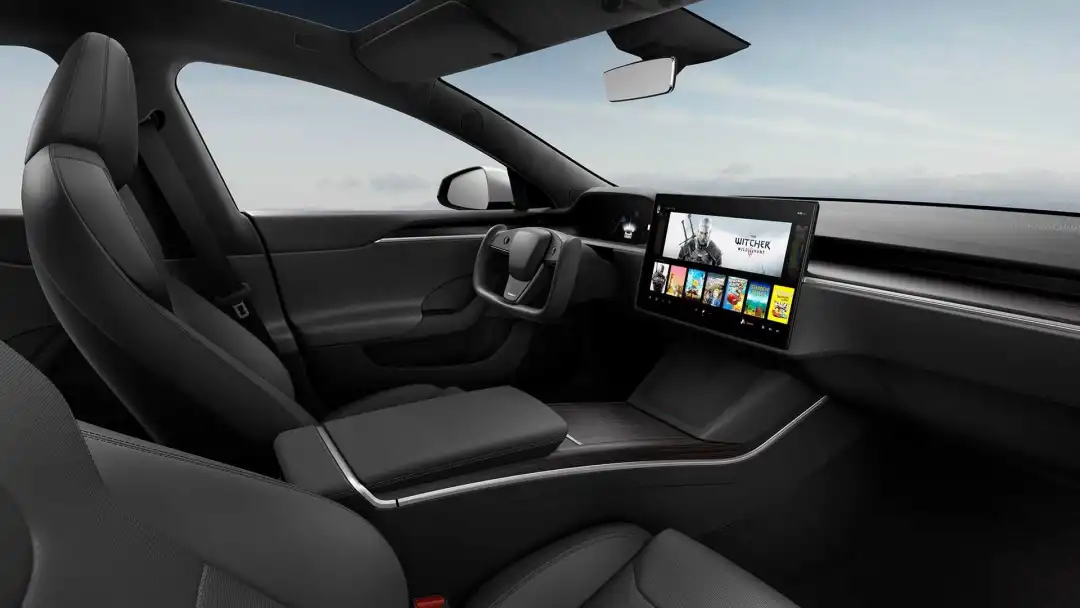 From the picture, the most obvious changes are the addition of a yoke-style steering wheel similar to a racing car, the switch from a vertical to a horizontal screen, the addition of a screen in the rear, and the disappearance of the physical gear shifter.
From the picture, the most obvious changes are the addition of a yoke-style steering wheel similar to a racing car, the switch from a vertical to a horizontal screen, the addition of a screen in the rear, and the disappearance of the physical gear shifter.
Of course, there are also some minor changes, such as the addition of storage space and a wireless charging panel for mobile phones in the central armrest area and the change of the air conditioning vent to a hidden electronic outlet.
Today, we will explain two questions: Has the yoke-style steering wheel really been adopted? And how does the gear shifting work?
To answer the first question, the new Tesla Model S/X still comes with a traditional steering wheel, but in countries where it is allowed by policy, a racing-style steering wheel is optional.
The square steering wheel has the disadvantage that the driver cannot comfortably turn the steering wheel, but it has the advantage of unobstructed visibility above, allowing the driver to have a broader field of vision ahead. This function is supposed to encourage users to use driving assistance.
To answer the second question, Tesla has indeed eliminated the physical gear shifter, but a Force Touch touchpad is installed beneath the wireless charging pad on the center console. In extreme scenarios, the driver can manually control the vehicle’s gears.
Of course, Tesla is not intentionally making things difficult for drivers, but rather hopes to further liberate drivers and allow vehicles to make decisions independently based on real-world scenarios. In other words, the vehicle will shift gears on its own.
For example, if a Model S/X is facing a wall in a garage, it will detect the situation and switch to reverse after the driver steps on the brake pedal. If the vehicle is using Autopilot, it will automatically determine the driving mode and shift gears. Musk tweeted that once you get used to the automatic shift system, using manual shift will become very annoying.
We have not experienced the actual car, and this method sounds suitable for foreign lifestyles, but in China, with its highly complex environment, we still have some doubts.
To quote editor-in-chief Xiaokang from “New Car One Lecture”: Tesla hopes to further liberate drivers and use the system’s intelligence to enhance the automation of driving behaviors.
Comparison
If we compare Tesla’s latest cockpit design with Mercedes-Benz’s, we can understand what it means to be unexpected.Following the current trend in the automotive industry, Mercedes-Benz has introduced a “digital art piece”-like large screen that, combined with “zero-level operation,” takes beauty and practicality to a new level, fully meeting consumers’ understanding of technology.
Now let’s talk about Tesla, and it gets interesting. After removing the dashboard with the birth of Model 3, Tesla has been redefining cars in its own way and gaining market recognition.
Tesla: When people laughed at me for being crazy, I laughed at them for not seeing the future.
Luxury interior? Big or small screens? Art or not? Beautiful or not? I don’t even need a dashboard, gear lever, or even a gear position, yet I still ensure the same driving experience, even better.
Once I introduced the large screen, but you didn’t have it. Now that you all have it, you’re all discussing whether I am still killing myself, haha!
That’s it, where to argue? No point.
Conclusion
Mercedes-Benz’s MBUX Hyperscreen is a classic art piece in the tide of the times, constantly evolving based on the family language. It’s always so delicate and proud, not allowing any flaws, and always maintains elegance.
On the other hand, Tesla, after countless suicide innovative attempts, reconciled with itself time and time again, finally allowing us to see automotive products truly becoming a new species.
So, who can gain more market recognition in the end? Both are unique in their own ways.
This article is a translation by ChatGPT of a Chinese report from 42HOW. If you have any questions about it, please email bd@42how.com.
